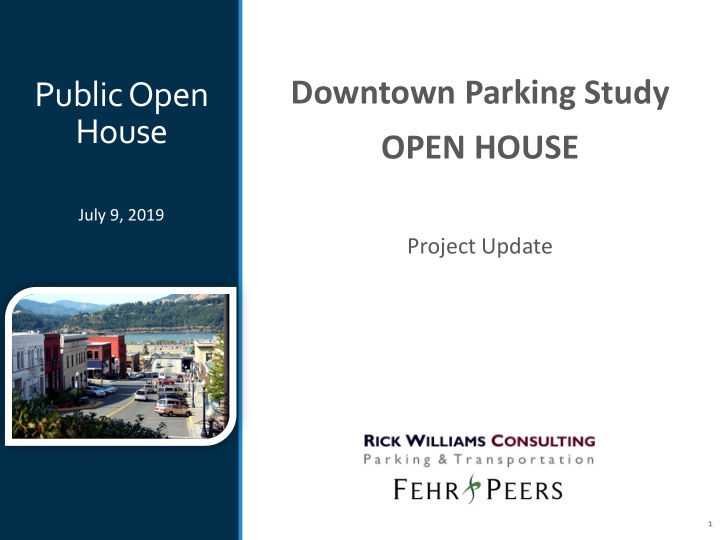



Downtown Parking Study Public Open House OPEN HOUSE July 9, 2019 Project Update 1
Agenda 1. Introductions 2. Project Status Report Rick Williams 3. Things we have learned Rick Williams 4. Q & A All 5. Next Steps Rick Williams 2
Data Collection (completed 2018) Ad Hoc Committee Process Task Status 5 meetings to date (meeting monthly) Issues research and analysis (drafts) Current parking demand (complete) Guiding Principles (complete) Parking demand forecast (complete) Barriers to residential development (complete) Fee-in-lieu (complete) Existing Conditions (underway) Shared Parking program (underway) Curb space management/new technologies (summer) 3
Public Engagement (June – September) Website ( http://ci.hood- Task Status river.or.us/Downtown_Parking_Study ) (cont.) Open Houses (July 9 and September) On-line Survey / Social Media Intercept Surveys Focus Groups (if data or information gaps) Strategy Development (July – September) Draft and Final Report (September – December) 4
Weekday - Current parking constraints Things we have learned On-street = constrained Off-street = opportunity (381 empty stalls at peak hour) 5
Weekend - Current parking constraints Things we have learned On-street = constrained Off-street = opportunity (418 empty stalls at peak hour) 6
Parking Demand Things we True Demand have True Demand: learned 1.31 to 1.38 vehicles per 1,000 ft 2 Calibrated True Demand: 1.51 to 1.59 vehicles per 1,000 ft 2 Code Required: 1.00 per employee + visitor parking 7
Things we have learned Forecasting Demand - Commercial Table 2: Study Area Demand – 20 YR Forecast Non-residential growth (ft2) @ 1% annually 2019 2025 2030 2035 2040 Cumulative @ Non-residential 793,539 833,216 874,877 918,621 964,552 20 Years ft2 Net growth ft2 (5 39,677 41,661 43,744 45,931 171,013 YR increments) 60 63 66 69 Net new parking @ 1.51/1,000 ft2* 258 Net new parking @ 1.59/1,000 ft2* 63 66 70 73 272 *[NOTE: Net new parking does not account for existing parking that might be removed to accommodate new development] - 21.5% increase in commercial land area (20 YR) - 18% increase in parking supply over 2018 (1,485 to 1,757) at 2040 8
Forecasting Demand - Residential Table 5: Estimated Parking Need for Future Residential Development Sample Development Size Parking Demand Ratio Parking Stall Need 5 units 1.27 7 stalls 10 units 1.27 13 stalls 25 units 1.27 32 stalls 50 units 1.27 64 stalls 100 units 1.27 127 stalls - Estimate of 64 stalls (@50 units) over 20 years based on rate of growth over last 14 years. 9
7 ELEMENTS OF PARKING Building MANAGEMENT IN HOOD RIVER Guiding Principles Priority Users Active Capacity Management Information Systems Integration with Other Modes Planning for Future Supply Financial Viability Roles and Coordination 10
Guiding Principles F. Financial Viability C. Information Systems A. Priority Users 1. Fiscal Stewardship: All parking 1. Branding & Wayfinding: Create a wayfinding 1. On-Street System (Downtown): The operations must be financially system for the downtown that links parking most convenient on-street parking will be sustainable. assets and provides directional guidance, preserved for the priority user: the preferably under a common brand or logo. customer trip. 2. Monitor & Report Utilization: Implement 2. On-Street System (Immediately Adjacent G. Roles and Coordination performance measurements and reporting to Neighborhoods): The most convenient facilitate decision-making. on-street parking will be preserved for 1. Primary Role (City of Hood River): the priority user: the resident and their The City’s role in providing public guests. parking is listed in priority order and includes: D. Integration with Other Modes 3. Off-Street System : Coordinate off-street parking resources (public and private) to I. Accommodating customer/visitor 1. Travel Demand Management: Encourage and meet employee demand; while balancing access downtown; facilitate increasing percentages of use, the need in public off-street facilities to particularly by employees, of alternative travel ii. Providing (in partnership with the also accommodate visitor needs. modes to free up parking capacity. private sector) reasonable access for downtown employees; iii. Facilitating residential and/or guest access in neighborhoods E. Planning for Future Supply B. Active Capacity Management immediately adjacent to the 1. Code & Regulation: The City’s development downtown. 1. Optimize Utilization: Manage the code should not be a barrier to new parking public parking system using the 85% 2. Primary Role (Private Sector): development, while ensuring that adequate Occupancy Standard to inform and Employee parking should be led by parking is provided and “right sized” to guide decision-making. the private sector and through Hood River’s unique environment. partnerships where the City can 2. Shared Off-Street Parking: Encourage 2. Funding: Planning for future parking supply reasonably participate (financially or shared parking in areas where parking growth will be strategic and routinely programmatically). is underutilized (within the downtown evaluated to ensure the City is ready to and remotely in facilities linked by 3. Stakeholder Support: Ensure that a respond to growth, recognizing that other modes). This will require an representative body of affected assembling funding for new growth takes active partnership with owners of private and public constituents time and will require a varied package of private parking supplies. routinely informs decision-making. funding resources (and partnerships).
Questions Q & A & Answers Questions and comments from the Community? 12
Continue Public Engagement (June – September) Website (http://ci.hood- river.or.us/Downtown_Parking_Study) NEXT Open Houses (July 9 and September) On-line Survey / Social Media STEPS Intercept Surveys Focus Groups (if data or information gaps) Strategy Development (July – September) Continue Ad-Hoc Committee process Draft and Final Report (September – December) 13
THANK YOU! http://ci.hood- river.or.us/Downtown_Parking_Study 14
Recommend
More recommend